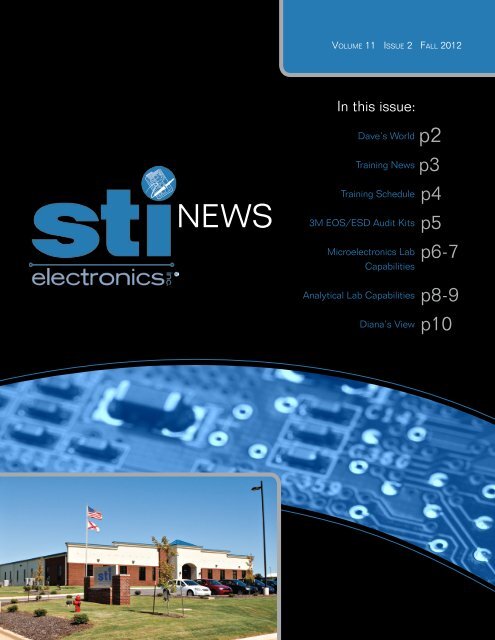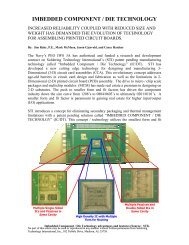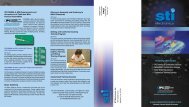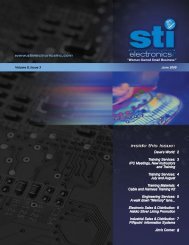Volume 11 Issue 2 - STI Electronics, Inc.
Volume 11 Issue 2 - STI Electronics, Inc.
Volume 11 Issue 2 - STI Electronics, Inc.
- No tags were found...
Create successful ePaper yourself
Turn your PDF publications into a flip-book with our unique Google optimized e-Paper software.
Vo l u m e <strong>11</strong> Is s u e 2 Fa l l 2012In this issue:NEWSDave’s WorldTraining NewsTraining Schedule3M EOS/ESD Audit KitsMicroelectronics LabCapabilitiesp2p3p4p5p6-7Analytical Lab CapabilitiesDiana’s Viewp8-9p10
2Dave’s worldContact Information:Dave RabyPresident/CEOdraby@stielectronicsinc.com2012 Summerby: Dave RabyI hope your summer was as much fun as mine.Around the end of May, I was sitting at my deskand the phone rang. It was Mike Buetow, Editor-In-Chief of Circuits Assembly and Vice President,Editorial and Production for UP Media.Mike called to inform me that UP Media hadstarted an <strong>Electronics</strong> Assembly Hall of Fameand not only was Jim (Dad!) the first inductee;they were naming it the Jim D. Raby Hall of Famefor <strong>Electronics</strong> Assembly. I’m not sure I’ve everseen Dad so proud of any recognition in his life.Even then, he immediately began naming thenames of others who he thought deserved thehonor more. All I can say is my (very biased?)opinion is that he deserves it. I can’t expressenough my appreciation to Mike and all of theother fine folks at UP Media for the honor andrecognition.A couple of months ago I was escorting a visitorout and while we were chatting in the lobby,three kids came in. I call them kids becausemore and more people seem like kids to mebut these guys were probably in their very early20’s. I was curious why they were at <strong>STI</strong> sowe started talking and they told me they wereUAHuntsville students and were working on aproject and needed some supplies. I rememberedmy college projects and how they usuallyended up involving a big dry cleaner’s bill anda visit from the fire department. When I askedthese guys what they were building, they said“A satellite. It will be launched next year.” Thatgot my attention. Then I started asking questionsand they started answering in a fashionthat made me realize quickly I was an ugly versionof Penny talking with Sheldon & Leonard.However, their excitement was very contagiousand I gave them a tour of <strong>STI</strong> and introducedthem to some of our people who had “realworld” experience and showed them manufacturingequipment and analytical equipment thatmight make their project easier. They do have abudget but it doesn’t touch capital equipment.I was amused/extremely impressed that theyhad needed to make some type of test chamberwhich they had no money for so they bought a$12 coffee maker and rearranged some partsand did their test. We discussed printing & stencils(they made their own from aluminum foil),pick & place (theirs is done by hand), reflow(toaster oven), cleaning (toothbrush), and inspection(20 year old eyes). Since that visit, theyhave been back and asked a lot of questionsand we’ve done some X-Rays for them. Theyhave also visited some other local companieswho are doing various types of work with them.I tell that story for a few reasons. I’m excitedabout an education that includes a hands onproject that gets students excited and involvesthinking and building. Our industry and ourcountry needs more young people growing upwith the ability to do both. In trying to help in thisregard, <strong>STI</strong> currently employs 3 UAH studentsthat do a variety of science and engineeringjobs. Starting this fall, we’ll have our first highschool intern from the nationally acclaimed BobJones High School Engineering Academy. I’malso always happy when a customer comes to<strong>STI</strong> for one reason (in this case, to buy a solderstation and a sponge) and we are able to fulfillthat need but also help in ways they hadn’tthought of. This happens fairly regularly in alldirections at <strong>STI</strong>.We’ve added 12 people at <strong>STI</strong> since the beginningof the year and I’d like to tell you about allof them. All are important to us but there aretwo I want to make sure I mention which are theones you are most likely to be dealing with. JulioEstrada has recently joined our world’s besttraining staff. Julio is a very experienced instructorfor IPC, NASA, and fiber optics. He will bebased out of Houston, Texas. Cathy Cross hasjoined our staff in the sales department. Cathybrings a lot of experience in training, assembly,and government contracting. Cathy will be inoutside sales covering Florida as well as southernGeorgia and southern Alabama.Thank you for your support and please let meknow how we can serve you better.You can follow us on Twitter (daveraby) or Facebook(<strong>STI</strong> <strong>Electronics</strong>) to keep up with our latestnews.David E. RabyP.S. If you would like to learn more about theJim Raby <strong>Electronics</strong> Assembly Hall of Fame,please visit http://circuitsassembly.com/cms/news/12923-up-media-group-opens-jim-d-rabyhall-of-fameIf you want to see more information on the satellitethe UAH students are building, visit https://sites.google.com/site/uahshc/projects/cubesatNEWS
3Training NewsBy: Pat Scott<strong>STI</strong> <strong>Electronics</strong>, <strong>Inc</strong>’s Training ServicesDepartment, announces the appointment ofJulio A. Estrada as its newest Instructor for theTX, OK, AR area.Julio brings morethan 15 years ofexperience intraining classesin through-holesoldering, cable,harness andcrimp assembly,f i b e r - o p t i ct e r m i n a t i o n ,p o l y m e r i ca p p l i c a t i o n s ,SMT fabrication and repair, as well aselectrostatic discharge (ESD) avoidance for theDid you know?• <strong>STI</strong> will be offering IPC/WHMA-A-620A SpaceAddendum Hands-On Course December 17-21, 2012.• The IPC/WHMA-A-620B will be publishedshortly followed by the development of the620B CIT and CIS Certification/RecertificationCourses. <strong>STI</strong> is fortunate to be working onthis curriculum development project.• The 2013 Course Schedule will be publishedsoon. The schedule will include training in thefollowing locations:» Alabama» Arizona» California» Florida» Georgia» Illinois» Minnesota» Nevada» New Mexico» New York» Ohio» TexasU.S. government. In total Julio has more than 28years of experience in the aerospace industry.He has trained personnel first on the NHB5300,then on the NASA-STD-8739 WorkmanshipStandards, and now on the IPC J-STD-001E,including the Space Addendum. Julio hasdevoted his entire career to helping othersachieve their goals by becoming proficient in thework they perform for their employers. He hasworked at respected companies including theJohnson Space Center in Houston, Texas andhas experience developing course curriculumsfor premier companies such as NASA.Julio has already instructed many coursesin Texas, Oklahoma and Arkansas. So keep<strong>STI</strong> in mind when selecting your local trainingprovider.• <strong>STI</strong> can conduct any IPC class on-site (J-STD-001, IPC-A-610, IPC/WHMA-A-620, IPC-A-600, IPC-77<strong>11</strong>/7721).• <strong>STI</strong> develops customized on-line trainingcourses.As you can see we keep very busy withscheduled classes, customized training coursesand curriculum development. <strong>STI</strong> continues tostrive to provide the highest quality training ata competitive price. For additional informationregarding our course schedule please visit ourwebsite at www.stielectronicsinc.com.In an effort to offer training to our customerscloser to home and reducing travel expenses<strong>STI</strong>’s Training Services Department will also beconducting several IPC classes on the road.We are going to start with several classes inCalifornia which will be held at Hakko located inValencia CA. These courses will be conductedin a traditional classroom environment. This isjust a start. We plan on offering more of thesecourses throughout the US. For details visit ourwebsite at www.stielectronicsinc.com.Regards,Director of Training Services256-705-5528 (Desk)256-527-6758 (Cell)Training ServicesContact Information:Pat scottdirector of training services256-705-5528 [desk]256-527-6758 [cell]pscott@stielectronicsinc.com
4Training ScheduleTo register for a course or foradditional information go towww.stielectronicsinc.comor e-mail us attraining@stielectronicsinc.com.FALL 2012Month Date Class LocationOCt. 31 IPC J-STD-001 Certified IPC Trainer (CIT)Recertification ProgramNOV. 2 J-STD-001ES Update, Space ApplicationAddendum to J-STD-001E5 IPC/WHMA-A-620 Certified IPC Trainer (CIT)Recertification Program7 IPC Rework/Repair and Modification CertifiedIPC Trainer (CIT) Recertification Program7 IPC-A-600 Certified IPC Specialist (CIS)Training Program12 MSFC/NASA 8739.1 Staking and ConformalCoating Certification Course12 IPC-A-610 Certified IPC Trainer (CIT)Certification Program19 IPC J-STD-001 Certified IPC Trainer (CIT)Recertification Program19 IPC-A-610 Certified IPC Trainer (CIT)Recertification Program26 IPC Rework/Repair and Modification CertifiedIPC Trainer (CIT) Certification ProgramDEC. 3 IPC-A-610 Certified IPC Trainer (CIT)Recertification Program5 IPC J-STD-001 Certified IPC Trainer (CIT)Recertification Program7 J-STD-001ES Update, Space ApplicationAddendum to J-STD-001E10 IPC J-STD-001 Certified IPC Trainer (CIT)Certification Program10 IPC/WHMA-A-620 Certified IPC Trainer (CIT)Certification Program17 IPC/WHMA–A-620AS Hands-On (CIT)CertificationMadison, ALMadison, ALMadison, ALMadison, ALMadison, ALMadison, ALMadison, ALMadison, ALMadison, ALMadison, ALMadison, ALMadison, ALMadison, ALMadison, ALMadison, ALMadison, ALNEWS
5salesMetcal to Host Advanced Package Rework and Repair Workshopat <strong>STI</strong> <strong>Electronics</strong>, <strong>Inc</strong>. AlabamaWhen: Thursday, October 25, 2012Where: <strong>STI</strong> <strong>Electronics</strong>, <strong>Inc</strong>.261 Palmer Road, Madison, AL 35758Also hosted by Mfg. Representative:Tim Glasgow, Managing Partner,REStronics SoutheastPhone: 770–634–4131Email: smtpro@aol.comWorkshop Hours: 9:00 AM to 12:00 PMPlease join us for a continental breakfast at8:30 AM / lunch at NoonSpend the morning with the experts fromMetcal to see the latest in rework andrepair technology. At this workshop, youwill learn the latest techniques to reworkand repair BGAs, QFNs and Micro SMDs.See live rework demonstrations withreal-life applications learned from globalexperiences. Be one of the first to see thenew Metcal Scorpion Rework System inaction.Rework WorkshopThe workshop will include a 30 minutemulti-media presentation, 2 hours ofhands-on demonstrations and instruction,and a Question and Answer session toconclude.No charge to attend but you must registerin advance as there is limited spaceavailable.Go to http://seminars.metcal.com/ toregister or to see complete details forupcoming workshop.Metcal Scorpion Rework SystemApplications & Topics• Repair, Rework• Low <strong>Volume</strong> Assembly• Prototyping• Screen Printing for Single Components• Flux Gel Deposition for BGA/CSPRework and Repair• Temperature Profiling for Rework andRepair• Rework and Repair Site PreparationWho Should Attend• Manufacturing Engineers• Production Managers• Production Supervisors• SMT Process Engineers• Quality Assurance Managers• Production Engineers• Repair Managers and Technicians• R&D ManagersContact Information:kelli kinginside sales manager800-858-0604sales@stielectronicsinc.comAs Dottie transitionsto Outside Sales coveringAL, MS, TN, andGA, joing us in welcomingCortney Wright as<strong>STI</strong>’s new Inside SalesRepresentative!
26microelectronicslabContact Information:casey cooperelectrical Engineering manager256-705-55<strong>11</strong>ccooper@stielectronicsinc.commicroelectronics laboratory capabilitiesBY: casey cooperIn the last newsletter, we discussed <strong>STI</strong>’s capabilitiesto support the design and manufacturing of advancedmicroelectronic assemblies. This article will explorein greater detail the benefits of manufacturing and assemblyof microelectronics within a cleanroom facility.Driven by the manufacturing precision and assemblycleanliness requirements of advanced microelectronicassemblies, nearly all microelectronic assembliesare manufactured in a clean environment meeting aminimum ISO Class 7 (Class 10,000) rating in order toproduce high yield of these types of devices.Because a cleanroom environment is critical whenmanufacturing and assembling high reliability electronicsystems, <strong>STI</strong> installed an ISO Class 6 (Class1,000) cleanroom environment in which to performresearch and development (R&D) in the area of microelectronicsin addition to supporting low-to-midvolume manufacturing of semiconductor packages/assemblies. <strong>STI</strong>’s Microelectronics Laboratory isequipped for back-end processing of microelectronics,from component-level packaging to system-levelassembly, within its tightly controlled cleanroom environment.<strong>STI</strong>’s Cleanroom Facility ConstructionAdvantagesThere are many factors to consider when selectinga cleanroom facility to manufacture and assemblehigh reliability electronic systems. The design andinstallation of the cleanroom facility ranks among thetop. For microelectronics-grade cleanrooms, key factorsinclude cleanliness (particle concentration andoutgassing requirements), facility layout (equipmentrequirements, airflow patterns, maintainability), manufacturingenvironment (operating temperature andhumidity, personnel requirements), and more. Eachfactor can play a significant role in the quality andyield of the end-product microelectronic assembly.• Cleanliness – The term “the cleaner, the better”couldn’t apply more than to microelectronic/semiconductormanufacturing and assembly. However,“cleaner” comes with a pretty high price tag. Toachieve “cleaner” requires the purchase and continuoususe of a greater number of fan filter units (FFUs)within the cleanroom in order to meet the requiredair changes per hour to achieve particulate levels ofthe lower ISO Class requirements. <strong>STI</strong> designed andcertified its cleanroom to ISO Class 6 requirements(less than 1000 particles of size 0.5um diameter andgreater per cubic foot of air space). This low concentrationof particulates within the assembly spacedramatically reduces opportunity for process defects,typically seen during interconnect formation such asultrasonic or thermosonic bonding.• Outgassing – Particulates are not the only source ofconcern for air cleanliness within a cleanroom. Outgassingof construction materials can also contributeto contamination issues that lead to quality and yielddefects. For instance, outgassing of sealants usedto seal joints in the cleanroom structure (e.g. wall-tofloorand wall-to-ceiling joints) are prone to emittingvolatile organic compounds (VOCs) that can depositon assembly surfaces reducing bond strengths andleading to potential corrosion issues. <strong>STI</strong> utilizednon-outgassing urethane-based sealant productsthroughout the cleanroom and carefully analyzed allwall, floor, ceiling, light fixture, FFU, and work stationconstruction materials to eliminate gaseous contaminationof die and substrate surfaces.• Facility Construction – Unidirectional, or laminar,flow cleanrooms are required for the most stringentcleanliness requirements (Class 100 and lower) andrequire perforated floors to implement. These notonly cost more to implement, but they also requirespecial support structures for high accuracy assemblyequipment in order to meet the equipment’s ratedaccuracy specifications. <strong>STI</strong> implemented a mixedairflow design to meet ISO Class 6 requirements utilizinglow wall returns and strategically placed HEPAFFUs to create airflow patterns that effectively removeparticulates from the space.• Expansion and Upgrade – There are many typesof cleanrooms including modular soft wall and freestandinghard wall constructed spaces. <strong>STI</strong>’s freestandingcleanroom was constructed of smooth cleanablealuminum composite wall panels which enableeasy expansion for future growth to accommodatehigher production volume and/or increased processcapability. <strong>STI</strong>’s smooth T-grid ceiling constructionallows design flexibility in placement of FFUs, lights,and ceiling panels facilitating easy upgrade to highercleanliness ratings through replacement of ceilingtiles with HEPA FFUs. While designed and certifiedto meet ISO Class 6 Operational Requirements, <strong>STI</strong>installed 50% additional FFUs than the average quantityrequired thus allowing <strong>STI</strong> to have much cleanerNEWS
37microelectronics laboratory capabilities(Continued)dedicated work areas for higher product quality andassembly yield.• HVAC – Perhaps the most critical factor in cleanroomperformance is the HVAC design and implementation.The HVAC system primary role is to supplyairflow in sufficient volume and cleanliness levelto meet the operational rating of the space, to conditionair to meet temp and humidity requirements,and to provide conditioned make-up air to cover airlosses and maintain positive pressure requirements.<strong>STI</strong> contracted an engineering firm to perform thesensible and latent loads presented by the surroundingenvironment, equipment operation, and personneloccupancy. The resulting load calculations droveequipment selections for the building controls, airhandling units (AHUs), humidifiers, and reheat systemsto ensure that temperature and humidity levelswere met under standard operational conditions.<strong>STI</strong>’s Cleanroom Operational ProceduresWhile design and installation of a microelectronicsgradecleanroom is the first step, it is the daily operationand routine maintenance of a cleanroom facilitythat can have the greatest impact on quality andyield of the end-product microelectronic assembly.<strong>STI</strong>’s cleanroom lab is certified in accordance withNebb Procedural Standards per the requirements ofISO14644-1:1999 for ISO Class 6 (Class 1000) ManufacturingCleanroom for Electronic Hardware in itsOperational State. It meets the requirements to producemilitary, space, and medical devices that requirecleanroom manufacturing standards and practices.<strong>STI</strong>’s cleanroom lab is operated in accordance withISO 9001:2008 requirements where quality controlis implemented in the earliest phases of an assemblyprocess beginning with particulate concentrationmonitoring, garment laundering, routine janitorialservices, HVAC preventative maintenance and filterreplacement, and rigorous operating procedures forgowning, facility usage, and equipment usage.• Pressure Differential – Gowning procedures andeffective cleaning of all equipment and/or assemblymaterials before entering an assembly areaaids to minimize contamination of the cleanroomspace. Room entrances have pressure differentialsto ensure flow from cleanest space to least cleanestspace and eliminate cross contamination. <strong>STI</strong>’s intakeof makeup air is set to create a minimum pressuredifferential between clean areas of 0.05 incheswater column keeping the main assembly space atthe highest pressure. Routine particle concentrationmonitoring is performed at assemble work surfaces toensure compliance of ISO14644-1:1999 for ISO Class6 (Class 1000) operation.• Garments – Occupants of a cleanroom can havea significant impact on the operational cleanlinesslevels attained in a cleanroom facility. <strong>STI</strong> enforcesthe use of coveralls, gloves, foot covers and boots,face masks, and head covers to minimize the releaseof particles into the cleanroom space. Ion-free,particulate-free gloves are used to handle materialsand devices to ensure contaminate-free surfaces andprevent formation of corrosive elements on assemblysurfaces.• ESD – With the use of static dissipative garmentsand dissipative sheet vinyl (non-outgassing) flooring,the risk of generating ESD during the manufacturingprocess is dramatically reduced. <strong>STI</strong> further combatsESD by the installation of pulsed-DC ionizers over allFFUs in order to discharge ESD generated by thehigh velocity airflow in order to meet the ISO Class 6air change over requirements. Lastly, all workstationsand assembly equipment in <strong>STI</strong>’s cleanroom includeground straps for dissipation of static when in directcontact with devices and assemblies.• Temp/Humidity Control – Temperature and humidityaffect not only assembly material properties butalso impact static control and comfort levels for theoccupants as they manufacture the microelectronicassemblies. <strong>STI</strong> utilizes a building control system tomodulate cleanroom space temperature to 70° ±2°Fand relative humidity to 45% ±5% to ensure processcontrol, maintain static-safe ESD levels, and a comfortableworking environment when working in cleanroomgarments.• Routine Maintenance – The performance of a cleanroomfacility will degrade over time if HVAC filters arenot routinely replaced, if garments are not routinelylaundered, and if the facility is not cleaned routinely(and cleaned with non-degrading, non-contaminatingcleaning agents). <strong>STI</strong> uses lint-free wipes, neutraldetergent (ESD-compliant), and filtered IPA and/or DIwater for cleaning during and after assembly processes.<strong>STI</strong> utilizes differential pressure sensors acrossthe filters to validate replacement schedules in orderto maintain cleanliness levels. A particle counter isroutinely used to validate cleanliness levels in a rangeof particle sizes to ensure continuous compliancewith ISO14644-1:1999 Class 6 requirements.microelectronicslab
8Analytical labContact Information:marietta lemieuxanalytical lab manager256-705-5531mlemieux@stielectronicsinc.comSEM/EDSBY: Marietta LemieuxWhat are they?SEM stands for Scanning Electron Microscopyand is an electron microscope in which the surfaceof a specimen is scanned by bombardingit with a beam of electrons that are reflected toform an image.Some of the advantages that the scanningelectron microscope has over traditional microscopes,are:1. A large depth of field, which allows moreof a specimen to be in focus at one time.2. A much higher resolution, so closelyspaced specimens can be magnified atmuch higher levels.3. Strikingly clear images.All this makes the scanning electron microscopea useful tool in the any failure or materialanalysis.EDS stands for Energy Dispersive X-ray Spectroscopyand makes use of the x-ray spectrumemitted by a solid sample bombarded with a focusedbeam of electrons to obtain a localizedchemical analysis.A typical EDS spectrum is portrayed as a plot ofx-ray counts vs. energy (in keV). Energy peakscorrespond to the various elements in the sample.Generally they are narrow and readily resolved,but many elements yield multiple peaks.If elements are present in low abundance thex-ray peaks that may not be resolvable from thebackground radiation.What do they do?SEM• Used for high magnification imaging -can get images up to several thousandX• Can differentiate between different materialson sample via Backscatter ElectronImaging (grayscale variation)• Topographical view via Secondary electronImaging• Measurement in the micron level (e.g.IMC layer or thickness of plating)EDS• Quantitative Elemental analysis• Can identify individual elements startingwith carbon on the periodic chart andheavier elements• 5/10kV acceleration potential for surfaceanalysis, 20/30kV acceleration potentialfor deeper sample penetrationExamples of SEM/EDS usage• Solder joints; IMC formation - In order tohave a good solder joint, one must forminter-metallic layers between the soldermaterial and the base metal. Otherwise,the solder simply solidifies over the basemetal without forming any bond.• Fractured solder connectionsNEWS
9SEM/EDSAnalytical lab• Proper solder joint formation; Ball collapse, wetting angles, sufficient PTH hole fill• Die evaluation, EOS or ESD damage• PCB issues: Inner-layer separation, broken traces, PTH barrel fractures/plating issues• Surface evaluation: Corrosion, PCB surface contamination, Plating issues• EDS: SpectrumShould you have any questions or would likea formal quote generated, please feel free togive us a call. Debi Bonkoski (256-705-5544) ormyself, will be more than happy to be of assistance.Marietta Lemieux (256-705-5531)
NEWSdiana’s viewdiana bradford, Vice President, Operations/Training ResourcesContact Information:diana bradfordvice president, operations/training resourcesdbradford@stielectronicsinc.com<strong>STI</strong> supports its customer base through one ora combination of all three divisions. Currentlythose divisions are: Engineering Services,Training Resources and Assembly/SolderSupplies.In this newsletter article, I would like to spend afew moments introducing you to the productsand services available to you through theAssembly/Solder Supplies group as well as thesupport personnel. <strong>STI</strong> is a stocking distributorof over 180 different product lines including OKI,PACE, Hakko, TechWear, MicroCare, Xcelta,3M to name a few. In addition to the full line ofproducts, this group consists of three inside salesrepresentatives (Kelli King, mgr., Cortney Wrightand Julia Adamczyk) as well as three outsidesales representatives (Cathy Cross, Jack Harrisand Dottie Grantham). In addition to the salesstaff, the warehouse staff, James Nicholsonand Roger Hammonds, provide delivery andinventory support to local companies. <strong>STI</strong> offersengineered sales support as well as Vendoror Customer Managed inventory solutions.Inventory solutions can take multiple forms.Inventory can be managed as consignmentwith a scanner based set-up or vendingsystem configurations. <strong>STI</strong>, through a solutionscontract, can ensure that a company always hasassembly and manufacturing critical supplies onhand. To get more information on how <strong>STI</strong> cansupport your inventory needs, please contactus today at sales@stielectronicsinc.com. Welook forward to hearing from you!Kelli KingCortney WrightJulia Adamczykcathy crossJack HarrisDottie GranthamJames NicholsonRoger Hammonds







